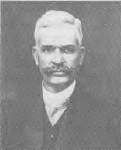- Author
- Ogle, Brian
- Subjects
- History - general
- Tags
-
- RAN Ships
- None noted.
- Publication
- June 1997 edition of the Naval Historical Review (all rights reserved)
At Deakin’s request, the whole subject of Australian naval defence, including Creswell’s proposal, was considered by the Committee of Imperial Defence. Its arrogant conclusions hammered one of the final nails into the Admiralty coffin:
- “A possible raid on Australia is of secondary importance”.
- It dismissed Creswell’s proposals for destroyers as “lacking strategical justification for coastal defence”.
- To add insult to injury, the same Committee of Imperial Defence had assured the House of Commons only 12 months before that destroyers and torpedo-boats would provide coastal defence in the UK.(Jose, p.xxvi).
Public distrust of Admiralty proposals forced action from the Australian Government. In 1907 a sum of £250,000 was voted for local naval construction, but Deakin kept it on the back burner.

Labour Prime Minister who, in 1909, bought Australia’s first warship.
We now have to consider a double-header; an event in Australia and another in the UK which brought naval thinking to a head, Empire wide. In August 1908 the United States fleet sailed through the Heads and swung around the buoys in Sydney Cove. The “great white ships” and their crews had a profound impact. (My mother, 18 at the time, and my aunt, 16, assured me that this was so). Consensus of Australian opinion was if the Yanks could have a navy so should we. Andrew Fisher the new Labour PM. took the £250,000 off the shelf and ordered three destroyers to be delivered as soon as possible.
In Europe Kaiser Wilhelm II, thumbing his nose at his Uncle Edward VII of England, was building and commissioning ships ad nauseam. So serious was the threat that Commons, press and people, demanded expansion of the Imperial Navy. With Admiral Jacky Fisher at the helm, Admiralty was ready to go. But there was a problem – one which our Mr McDonald (Kennedy, Qld.) had forecast in 1901:
“There is no power, in my estimation, that can continually go on arming itself, as Great Britain is doing, without sooner or later causing her people to groan under the burden of taxation“. (Reps. Debate, p.3521).
The Kippers, to use RAN terminology, were screaming. Why should they bear the whole expense of naval defence? The Colonies should chip in. The New Zealanders gave them a Dreadnought, Canada “fait la sounde oreille”. Fisher said, “I’ll do it my way”. Unfortunately he was fandangled out of office shortly afterwards. The new Government, a “fusion” of Deakin’s psuedo-liberals and Joe Cook, renegade ex-Labour leader, being neither fish nor fowl, spent much time watching the other or compromising as they did on the naval question. A Colonel Foxton was drafted to the Imperial Defence Conference offering the alternative of a free Dreadnought or more expenditure on a local squadron.
Admiralty accepted the latter and proposed an independent Australian Fleet Unit consisting of:
- Armoured battle cruiser
- Unarmoured cruisers
- Destroyers
- Submarines
This squadron to be manned by Australian officers and men and to be under the exclusive control of the Commonwealth Government. K. R. and A. I. was to be the big, blue regulating book and if Britain declared war the R.N. took over the quarterdeck.
The Commonwealth Naval Loan Bill No. 14 of 1909.
The Cost and How-to-Raise the Money
All hands having conceded the vital necessity of Australia owning and manning its own navy, the question was again, “how to pay for something of a totally unproductive nature?.” Estimated cost was £3,750,000 sterling of which Britain volunteered a subscription of £250,000. Money was to be constitutionally voted. Thus it was again once more into the breach as dear friends and opposition argued the pros and cons of financing by borrowing or by direct taxation.
In the “Fusion” government Sir John Forrest, defence minister in 1901, was now treasurer. He had not changed his view on monetary policy one iota. In fact his biographer recounts that as Premier of Western Australia Forrest raised such huge loans in London, that the W.A. public debt rose from £1.4 million to £12.2 million in 10 years. As treasurer he had budgeted for a deficit. He was vehemently anti-socialist and believed that Australian defence was a matter of Imperial strategy and not of Colonial initiative; a fellow not likely to be a success in charge of the wardroom grog cabinet.




